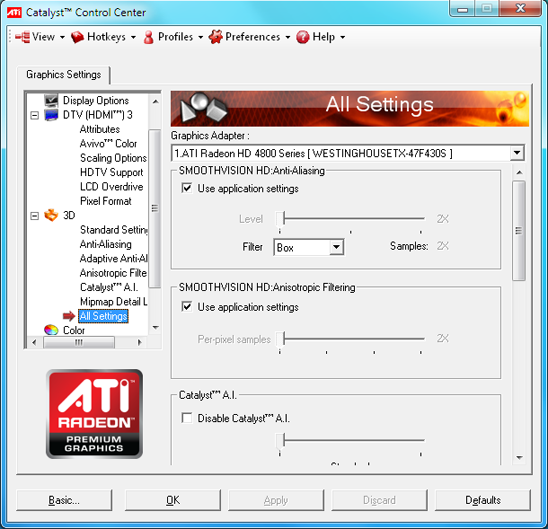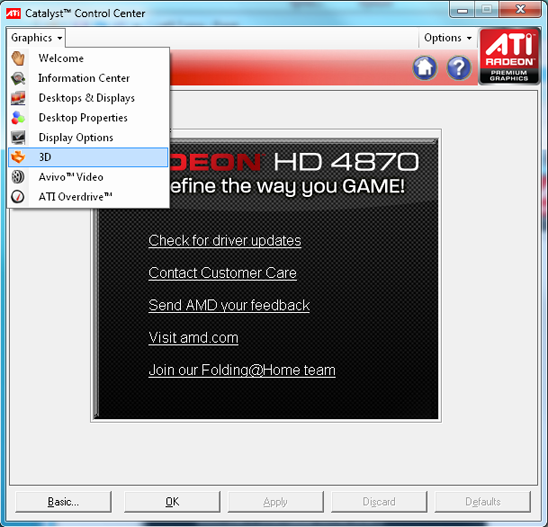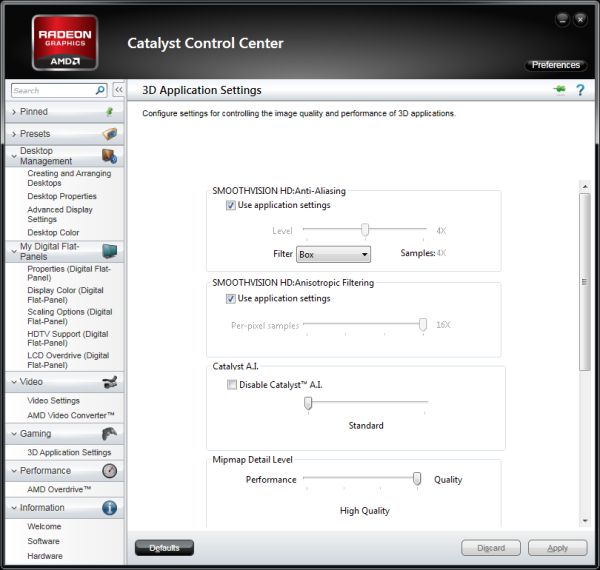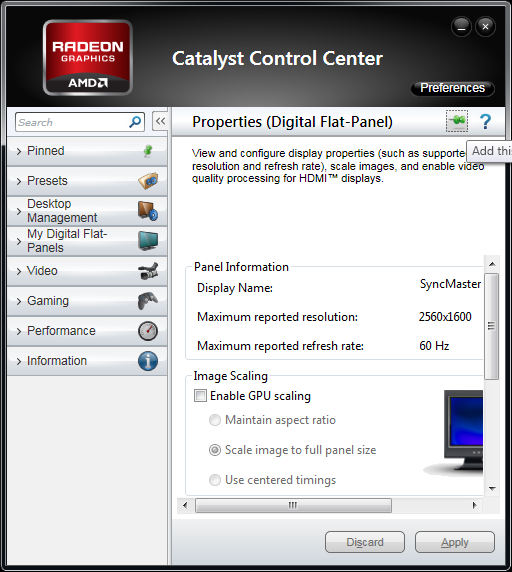AMD Previews New Catalyst Control Center Interface
by Ryan Smith on December 13, 2010 12:01 AM ESTAMD Previews New Catalyst Control Center Interface
Back on December 2nd AMD’s Catalyst Product Manager, Terry Makedon, posted an interesting if cryptic note on his Twitter feed: “Catalyst 10.12 is going to be HUGE”. Since then there’s been some speculation on just what was going to be huge, but nothing quite hit the mark until the last couple of days.
With release date for the Catalyst 10.12 driver set finally upon us, AMD has taken the wraps off of what they’ve been up to. The huge news? The Catalyst Control Center is getting a significant interface refresh; its latest since the middle of last year, and certainly the biggest one to date.
Before we get too far ahead of ourselves though, let’s start at the beginning. Catalyst Control Center, AMD’s GPU configuration control panel, is one of the last vestiges of the old ATI. Released back in 2004 to a tepid response, it has received a number of upgrades over the years (including a previous interface refresh only a year and a half ago) but is in a number of ways still the same utility since the ATI days. Going forward however, AMD has finally put the ATI brand to rest 4 years after the acquisition, and with the retirement the ATI branding those last vestiges of ATI are being modernized. In the case of the Catalyst Control Center, this means among other things replacing the red ATI livery with AMD’s green & black livery.

Catalyst Control Center up to 9.6

Current Catalyst Control Center
At the same time, Catalyst Control Center is about to become much more important. AMD purchased ATI because they foresaw the importance of having a graphics division to design GPUs for future CPU products with on-die GPUs – the newly christened APU. Work on integrating a GPU and a CPU started early so the importance of the hardware has always been self-evident, but software has been another matter. With AMD’s first APUs launching next year, the software side of the equation is finally coming together and it’s the Catalyst Control Center at the middle of it all (and the fact that we first saw the new CCC running on Zacate says a lot right there).
Going forward, the Catalyst Control Center will be AMD’s primary CPU/GPU/APU configuration utility. Today we’re just seeing the next evolution of the Catalyst Control Center as a GPU configuration utility, but next year AMD will start bringing in features for their APUs and CPUs. So in many ways this is just the first half of the story as we still don’t know just how the Catalyst Control Center will integrate CPU/APU controls, or for that matter what will become controllable.

New Catalyst Control Center (Advanced View)
As far as GPUs are concerned at the moment, the new Catalyst Control Center is more or less a reskin of the previous version. The functionality is still identical if not slightly outdated – the preview version still uses the old 3D Settings dialog for the pre-6000 series cards – but a fresh coat of paint can work some small miracles.
The biggest change is going to be for casual users, who previously had to choose between the full “Advanced” view, and the anemic “Basic” view. Basic was simple to the point of heavily limited functionality, and for that reason the bulk of the overhaul has been on the casual side of things. Basic is being replaced with the Standard view, which this time is an appropriately pared down version of the Advanced view. Standard uses a hierarchical organizational system to help point users to the right control panel, grouping together control panels on the basis of Video, Gaming, etc; and then things are subcategorized, such as the case is with the Anti-Aliasing and Ansiotropic Filtering control panels which make up the Image Quality subcategory of Gaming. Each category and subcategory has a short but to the point description of what the section does; Image Quality for example has the text “Changes settings to enhance image quality in games and other 3D applications”. All of this eventually leads to the individual control panels, which are basically unchanged from previous versions of the Catalyst Control Center.
Meanwhile for Advanced users the difference is much smaller. The loathed drop-down menu to select an individual control panel is gone, bringing back the tree view. In the process AMD has simplified the tree view to remove access to the redundant control panels meant for Standard use, leaving only the full control panels such as 3D Application Settings that let power users find and control everything about image quality at once. At the same time the desktop and display management control panels have been moved in to the tree, grossly simplifying the process of configuring these options (half of which were hidden in other control panels) and something that undoubtedly is going to be well received by monitor and HDTV users who could never find the Scaling Options and HDTV Support control panels respectively. Again it’s mostly a fresh coat of paint, but it’s definitely easier to find things than on the previous version of Catalyst Control Center.
Common to all views for the new Catalyst Control Center is resizability and pinning. Resizability has been a sorely needed feature for the Catalyst Control Center, as the fixed size window got along poorly with low resolution displays, particularly HDTV owners looking to setup their TVs when they default to 480P. The actual control panels are still a fixed size – nothing reflows to match the window size – but now the Catalyst Control Center allows scrolling to access the entire control panel through a fairly small window. Meanwhile pinning allows users in both views to add a control panel to a list of pinned pages for easy future access, though this is likely going to be much more beneficial to Standard users as a stepping stone to Advanced view than it will be beneficial to Advanced users.

Yes, They Have Resizing
AMD is touting the fact that they partnered with Infusion, a UI design firm, in order to design the new Catalyst Control Center. Whether Infusion deserves all of the credit or not, the fact of the matter is that the old Catalyst Control Center set a rather low bar, giving AMD/Infusion a clear path towards improving the Catalyst Control Center.
Going forward AMD is promising to make future improvements to the Catalyst Control Center. As we previously mentioned, we expect APU/CPU controls to be added to the Catalyst Control Center next year for AMDs upcoming products, though we don’t know quite what those controls will be. On the GPU side of things AMD is more specifically promising further improvements in display management, which has been a continually evolving process for the company as they adjust to feedback from Eyefinity users. Meanwhile we’re still holding out hope for proper (NVIDIA-style) application profiles after AMD has once again missed an opportunity to implement those. Generally speaking we’re indifferent towards AMD and NVIDIA's control panels, but that’s the one area where NVIDIA has a specific, significant edge.
For the time being, the new UI is going to be available as a preview with Catalyst 10.12. AMD will be releasing a regular version of 10.12 with the old version of Catalyst Control Center, and alongside it will be releasing a version of 10.12 with the same drivers but with the preview version of the new Catalyst Control Center instead. And it should be noted that the new Catalyst Control Center is for Windows Vista and later only – Windows XP users will be stuck with the previous version of the Catalyst Control Center. AMD is using some Vista/7 only features for the new Catalyst Control Center, particularly the Windows Presentation Foundation, which means it’s not (easily) backported to Windows XP.
Finally, in spite of the changes to both the interface and the underpinnings of the Catalyst Control Center, performance remains unchanged. We’ve clocked both the old version and the new version at around 1.5 seconds to launch on our GPU test rig and practically instantaneous switching between control panels.

















80 Comments
View All Comments
Shadowmaster625 - Monday, December 13, 2010 - link
There is no reason for a billion dollar company to outsource UI development. And there is definately no reason to use WPF and break backwards compatibility in any way aside from DX10 and DX11. These guys are idiots.Taft12 - Monday, December 13, 2010 - link
Why not? UI development is not their core business....fausto412 - Monday, December 13, 2010 - link
do we even need to install Catalyst if we just use the default settings anyways?i mean what does the driver by itself not do with Catalyst not installed?
Lagged2Death - Monday, December 13, 2010 - link
When the first .NET version of the Catalyst Control Center was released, I vowed that my next video card would be an NVidia based one, because CCC was so annoying.It consumes an enormous amount (~150-200 MB) of RAM, even when you're not using it, even after you close it. It is completely ludicrous that this should be necessary for a simple control panel.
It takes forever to start up. It has a serious impact on system boot time. It's possible to disable the load-at-boot arrangement, but it will take (even on a modern machine) 20-30 seconds to start on demand in that case. On the old machine I first encountered CCC on, it took over a minute to open.
The slider-type controls used everywhere in CCC are a UI design mistake. Very few other applications or control panels use sliders for any purpose, and for good reason: sliders are not "discoverable." That is, in order to find out how many options a slider presents, and what they are, you have to actually change the slider setting. In fact, in order to see what options are available, you have to try _every_ setting. And you have to remember what the original setting was, so you can put it back.
Drop-down combo boxes, list boxes, menus, and lists of radio buttons all make it possible for the user to 1) skim a list of choices that are all displayed at once and 2) see the choices available without changing the currently selected option.
Sliders are only the right choice when they're used to select a quantity on a continuous scale, like a percentage. They're never the right choice for a list of discrete, modal options, like AA mode or AF mode.
It was obvious from the start that the CCC designers were more concerned with making the application look cool than work well. This is a syndrome that effects far too many hardware control panel applications. It's inexplicable. If you built your own PC, your motherboard probably came with some awful control panel type application that is clumsy to use and needlessly graphically elaborate. And you probably don't use that horrible thing for exactly that reason. Why do hardware vendors do this? Look at this:
http://images.hardwarecanucks.com/image/mac/review...
Who thought that was a good idea? Who wants that?
The NVidia control panel starts up in a flash, looks like a standard Windows app, and releases the memory it uses when you close it. It does the job I need it to do and _that is all it does_ and that's the way it should be.
And this all sucks because the last few generations of ATI/AMD cards are really good, and I'd want one if it weren't for CCC.
iamezza - Monday, December 13, 2010 - link
I think they have improved the performance of CCC a lot lately (I agree it was bad for a while there)My CCC uses 3.5MB when not active, 35MB when active.
It takes around 2-3s to load after a reboot
each subsequent load takes less than 1 second.
mind you I do have an SSD though.
Belard - Tuesday, December 14, 2010 - link
Both Nvidia and ATI..er AMD interfaces are annoying in their own ways.I hated the CCC-.net, it was so crumble-some and offered little... wow, real-time effects.
But as stated, it doesn't really use that much memory and in todays world in which $40~50 buys you 4GB of RAM... its pretty much a non-issue.
The CCC panel opens up on my 2+ year old PC with Win7 in 1~4 seconds. My whole boot time is about 40seconds with an old-fashion spinning hard drive.
Apparently, the CCC isn't effecting game performance... and its rarely used.
And besides, the new panel is actually more customizable... its actually pretty nice.
Spivonious - Monday, December 13, 2010 - link
WPF is not a Vista/7 only platform. It's available in .NET 3.0 and newer, which is available for XP.sleepeeg3 - Monday, December 13, 2010 - link
Appreciate that AMD is trying, but not worthy of an article. Looks like a reskin. Maybe being able to tweak some more granular 3D settings would have been cool, but even then...Spartacus288 - Monday, December 13, 2010 - link
Now I have to deal with another program that refuses to use native widgets and just wants to do its own thing, ignoring my system theme. I don't want individual programs to look different from anything else, that's ridiculous. I want, when I make a system theme, for everything to look like my theme. Unfortunately, it looks like the majority of developers don't really care.HangFire - Monday, December 13, 2010 - link
Not that I'm surprised.Linux drivers and CCC are supposed to be on the same monthly release schedule as Windows, but reality trails.
Every third release supports KDE, the other two break it.
Release 10.6/10.7 was the most interesting. AMD never made up their mind which release it was. The d/l page was a mix of 10.6 and 10.7, the file name had 10.7 in it but it installed with 10.6 notes and docs.
Great job, AMD! Ha.